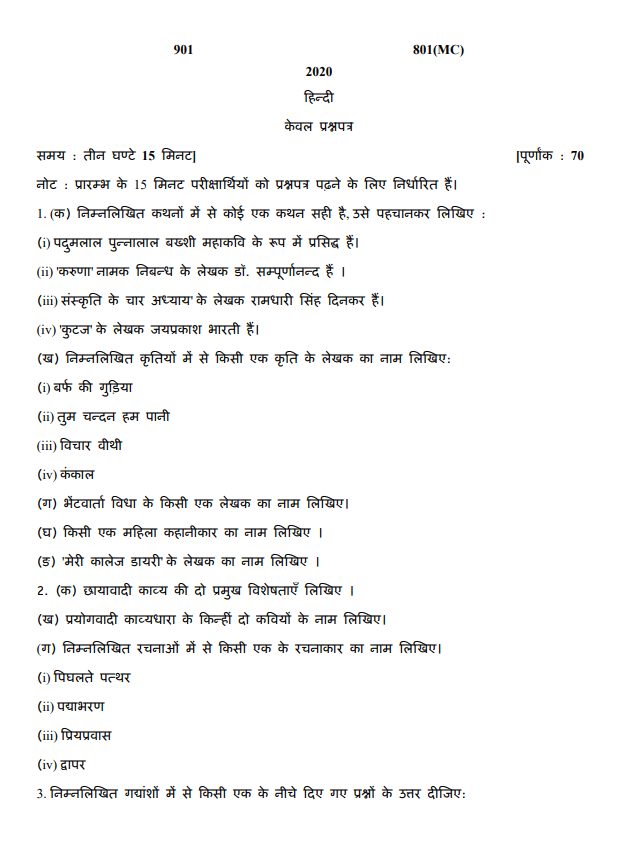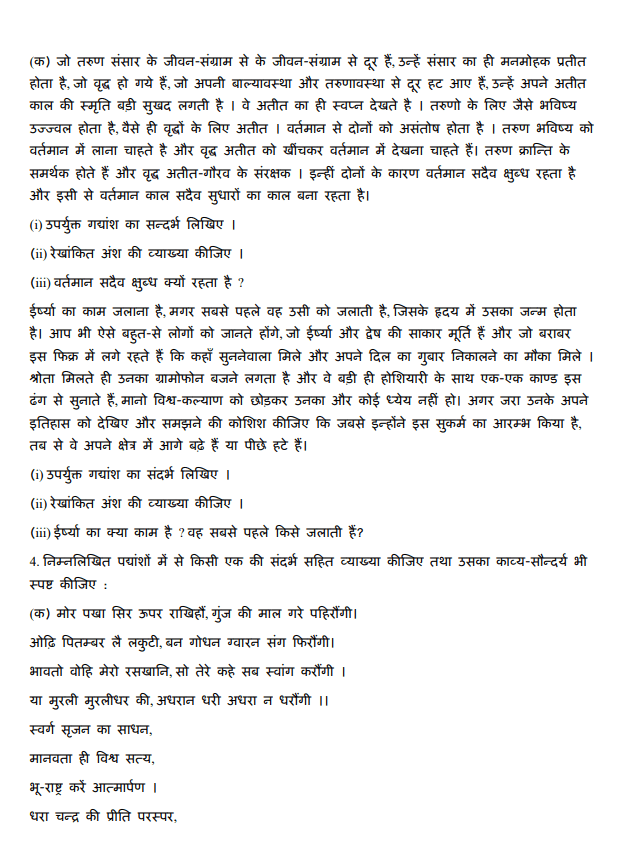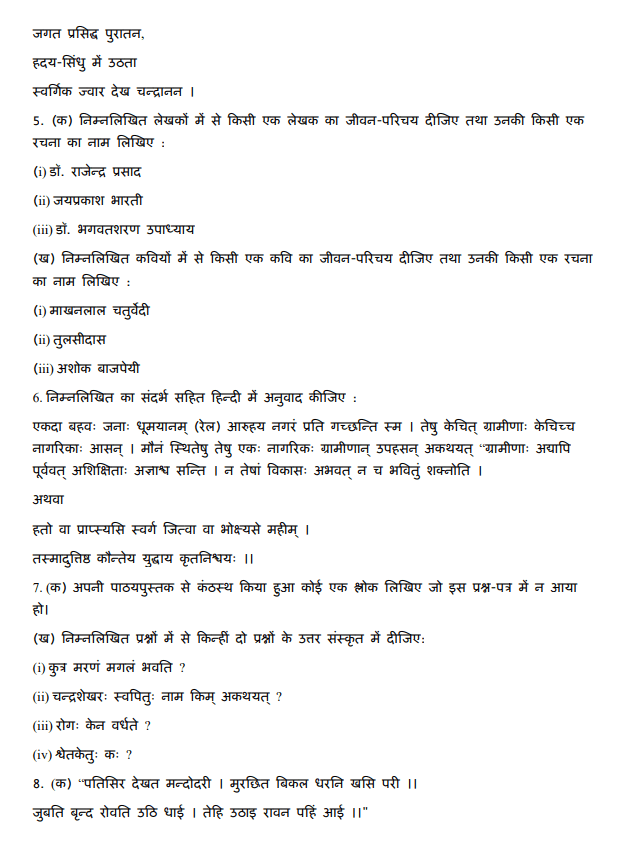UP Board Class 10th Hindi Model Paper 2022
Welcome to our blog dedicated to the UP Board Class 10th Hindi Model Paper 2022 Dive into our collection of model papers crafted specifically to aid your preparation for this important examination. Explore comprehensive resources and valuable insights to elevate your performance in the Hindi language exam.
- Introduction :UP Board Class 10th Hindi Model Paper 2022
- Download : UP Board Class 10th Hindi Model Paper 2022
- Syllabus : UP Board Class 10th Hindi Model Paper 2022
- Exam Pattern : UP Board Class 10th Hindi Model Paper 2022
- Significance of UP Board Class 10th Hindi Model Paper 2022
- Strategies For Effective Readines
- FAQs : UP Board Class 10th Hindi Model Paper 2022
Introduction : UP Board Class 10th Hindi Model Paper 2022
Regrettably, I am unable to furnish the authentic question paper owing to copyright constraints. However, I can furnish you with insights regarding the UP Board Class 10th Hindi Model Paper 2022 and direct you to resources conducive to your forthcoming examinations.
Expected Framework:
The structure of the UP Board 10th-grade Hindi paper likely encompasses three delineated sections:
Kaviyaansh aur Gadyaansh (30 Marks) (Poetry and Prose Segment):
This segment probably comprised undisclosed passages (both poetic and prosaic) entailing inquiries to evaluate your comprehension, lexicon utilization, and interpretative acumen. Presumably, queries could have entailed:
Succinctly summarizing the core themes of the passage.
Discerning the literary devices employed within the text (e.g., similes, metaphors).
Addressing specific queries contingent upon the passage content.
Lekhan Khel (40 Marks) (Writing Proficiency Segment):
This division ostensibly underscored your compositional prowess and creative expression. Notably, queries might have entailed:
Nibandh लेखन (Essay Writing): Presumably, a selection of themes could have been proffered, necessitating an essay composition within a stipulated word boundary.
Patra Lekhan (Letter Writing): Conceivably, you could have been tasked with drafting either a formal or informal epistle within a designated scenario (e.g., correspondence to an acquaintance delineating a memorable occurrence, an epistle to the editor articulating your perspectives on a societal issue).
Vartalaap लेखन (Dialogue Writing): It’s plausible you were required to devise a dialogue between two personages predicated on a provided context.
Vyakaran aur Rachna (30 Marks) (Grammar and Composition Segment):
This segment seemingly gauged your comprehension of Hindi grammar and syntactic framework. Presumptively, inquiries might have encompassed:
Sandhi (Sandhi): Application of sandhi rules (concatenation of terms) to formulate compound lexemes.
Vyakaran (Grammar): Discerning components of speech, verb conjugations, and rectifying syntactically flawed sentences.
Vakya Rachna (Sentence Structure): Reshuffling disordered lexemes to formulate grammatically accurate sentences.
Download : UP Board Class 10th Hindi Model Paper 2022
| Title | Question Paper |
|---|---|
| UP Board 10th Hindi Paper | Download Here |



Syllabus : UP Board Class 10th Hindi Model Paper 2022
Section A: Hindi Language (50 marks)
| Topic | Marks |
|---|---|
| Prose | 10 |
| Grammar | 10 |
| Composition | 10 |
| Translation | 10 |
| Textbook | 10 |
Section B: Hindi Literature (50 marks)
| Topic | Marks |
|---|---|
| Prose | 10 |
| Poetry | 10 |
| Drama | 10 |
| Supplementary Reading | 10 |
| Textbook | 10 |
Books Prescribed
- Vyakaran Praveshika – Part 1
- Hindi Sahitya Sanchayan – Part 1
- Hindi Gadya Sagar – Part 1
- Hindi Kavya Kosh – Part 1
- Prarambhik Hindi Vyakaran Tatha Rachna – Part 1
- Hindi Sahitya Sanchayan – Part 1
- Hindi Gadya Sagar – Part 1
- Hindi Kavya Kosh – Part 1
- Prarambhik Hindi Vyakaran Tatha Rachna – Part 1
Evaluation Scheme
| Term | Hindi Language | Hindi Literature |
|---|---|---|
| Term I | 25 | 25 |
| Term II | 25 | 25 |
Exam Pattern : UP Board Class 10th Hindi Model Paper 2022
Candidates need to be aware of the Class 10 Hindi exam marking scheme if they plan to take the UP Board test.
There are 30 questions in all on the UP Board Hindi question paper:
- 10 from the subjective segment and 20 from the objective component.
- The Hindi test paper for class 10 on the UP Board carries a total of 70 marks.
- The final 30 marks are given according to the results of the internal assessment.
- Each of the UP Board Hindi test paper’s objective questions is worth one mark.
The weightage of the objective section is 20 marks. The subjective section questions amount for a total of 50 marks. The marks for each question varies in the subjective questions. Each of the subjective questions are further divided into sub-parts. Candidates should focus on preparing the Padyansh, Gadyansh, and essays, as they are frequently asked in the exam.
Significance of UP Board Class 10th Hindi Model Paper 2022
The significance of UP Board 10th Hindi Paper lies in their ability to serve as valuable study resources for candidates preparing for the UP Board examination. Here are some key reasons why these question papers are important:
Exam Blueprint Revealed:
The actual exam is modeled by these papers. You can learn a lot about the arrangement of the questions, the relative importance of the various areas on the syllabus, and even the degree of difficulty by carefully examining them. This enables you to customize your study and give priority to the subjects that need greater attention.
Improving Your Skills:
Using past year papers for practice is similar to taking practice exams in a real exam setting. You get to put your speed, accuracy, and conceptual understanding to the test in a virtual setting. This assists in determining your areas of strength and weakness prior to the exam, enabling you to improve your strategy and reinforce your comprehension of important subjects.
Building Exam Stamina:
The Class 10 UP Board exam may have a time limit, therefore success depends on your ability to manage your time well. You can improve your endurance and time management abilities for the test by using previous year’s papers. You can learn to pace yourself, prioritize questions, and stay away from becoming bogged down on any one problem by practicing in a timed environment.
Increasing Confidence:
Completing last year’s papers successfully boosts your self-assurance and eases exam anxiety. Observing that you can appropriately respond to questions validates your understanding and inspires you to keep trying. Your overall exam performance is significantly impacted by this positive reinforcement.
Finding Recurring Patterns:
Although the precise questions won’t be asked again, reviewing previous exams frequently identifies patterns in the subjects and question types that are asked again. This enables you to create focused strategies for answering the kinds of questions you might encounter on the actual exam by anticipating their types.
It’s like having a secret weapon when you use the UP Board 10th Hindi Paper in your preparing approach. They sharpen your abilities, give you confidence boosts, and offer priceless insights, all of which considerably raise your chances of succeeding on test day.
Strategies For Effective Readines
Recognize the test and syllabus:
Visit the UP Board website (UP Board 10th Hindi Paper ) to download the official announcement and curriculum.
Recognize the format of the exam (number of sections, weighted scores, time allotment).
Learn everything there is to know about the subjects included on the curriculum for each area.
Create a Timetable and Study Plan:
Make a realistic study schedule with time allotted for each section based on the syllabus and your preferred method of learning.
Establish study times on a daily or weekly basis, and try your best to maintain them.
Be adaptable and make necessary changes to your plan, but consistency is essential.
Establish a Robust Base:
Pay close attention to the fundamental ideas in each area, paying particular attention.
Learn the fundamental, shortcuts, and approaches to solving problems.
Make Use of Educational Resources
Make use of top-notch study resources, such as online courses, textbooks, and coaching materials (if necessary).
Exam patterns and time management exercises can be learned by looking at previous year’s question papers and practice exams.
Consistent Practice:
Every day, complete practice questions from different sources.
Prioritize precision while progressively picking up speed.
Examine your errors and determine what needs to be improved.
By following these tips and dedicating yourself to consistent preparation, you can significantly increase your chances of success in the Class 10 UP Board Exam. Remember, the key is to start early, work hard, and stay focused on your goal.
FAQs : UP Board Class 10th Hindi Model Paper 2022
Q1: What topics are covered in the UP Board Class 10th Hindi Model Paper 2022?
A1: The model paper likely covers a range of topics including poetry and prose comprehension, writing skills such as essay and letter writing, and grammar concepts.
Q2: How can I effectively prepare for the Hindi exam using the model paper?
A2: To prepare effectively, utilize the model paper to practice comprehension, writing, and grammar exercises regularly. Pay attention to the format of questions and practice time management.
Q3: Are there any specific strategies for tackling the essay writing section?
A3: Yes, focus on brainstorming ideas, organizing your thoughts logically, and adhering to the word limit while writing essays. Practice writing essays on different topics to improve your proficiency.
Q4: What is the significance of practicing dialogue writing in the model paper?
A4: Practicing dialogue writing helps improve your ability to construct conversations between characters, enhancing your creative expression and communication skills in Hindi.
Q5: How can I use the model paper to improve my grammar skills?
A5: Use the grammar exercises in the model paper to identify and rectify grammatical errors, learn new grammar rules, and reinforce your understanding of Hindi grammar concepts.